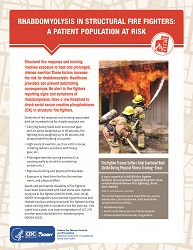Rhabdomyolysis in Structural Fire Fighters: A Patient Population at Risk
May 2018
DHHS (NIOSH) Publication Number 2018-134

Structural fire response and training involves exposure to heat and prolonged, intense exertion. These factors increase the risk for rhabdomyolysis. Healthcare providers can prevent debilitating consequences. Be alert to fire fighters reporting signs and symptoms of rhabdomyolysis. Have a low threshold to check serial serum creatine phosphokinase (CK) in structural fire fighters.
Elements of fire response and training associated with an increased risk for rhabdomyolysis are:
- Carrying heavy loads such as turnout gear and air packs weighing up to 60 pounds, fire fighting tools weighing up to 80 pounds and incapacitated building occupants
- High levels of exertion, such as victim rescue, climbing ladders and stairs with heavy gear, etc.
- Prolonged exertion during overhaul (i.e. opening walls to check for smoldering embers, etc.)
- Rigorous training and physical fitness tests
- Exposure to heat from the fire, the environment, and physical effort
Rhabdomyolysis in Structural Fire Fighters: A Patient Population at Risk [PDF – 3 MB]
